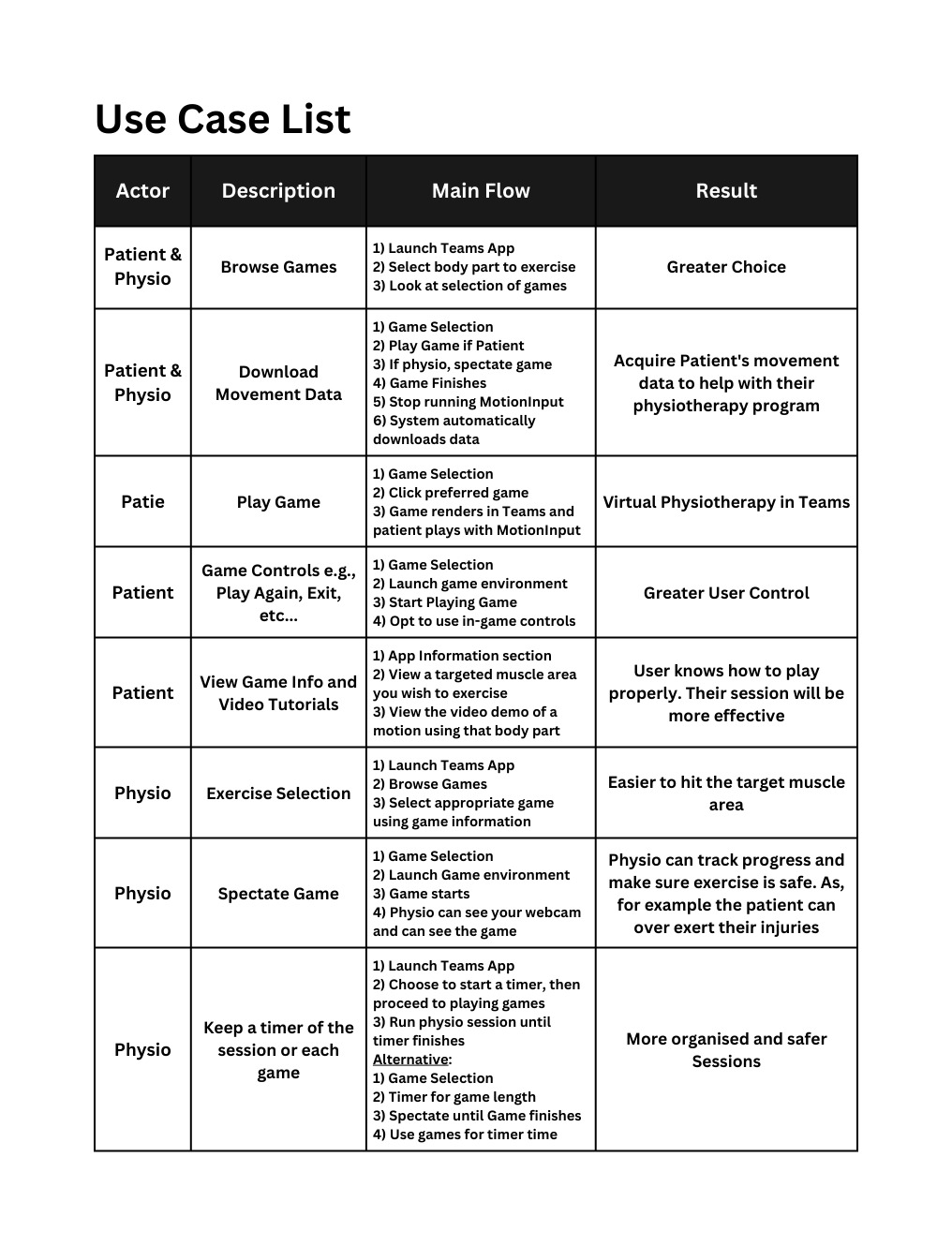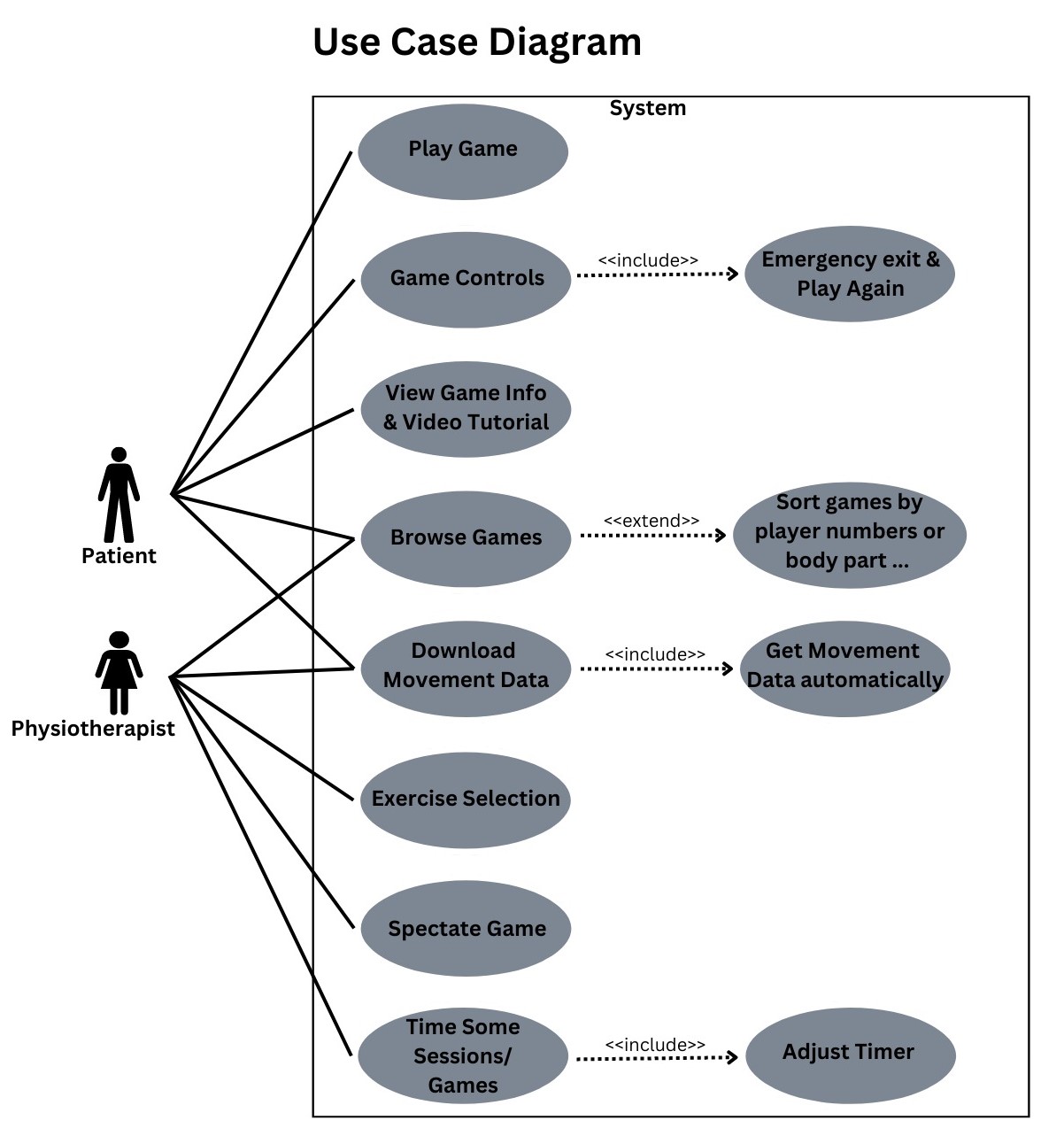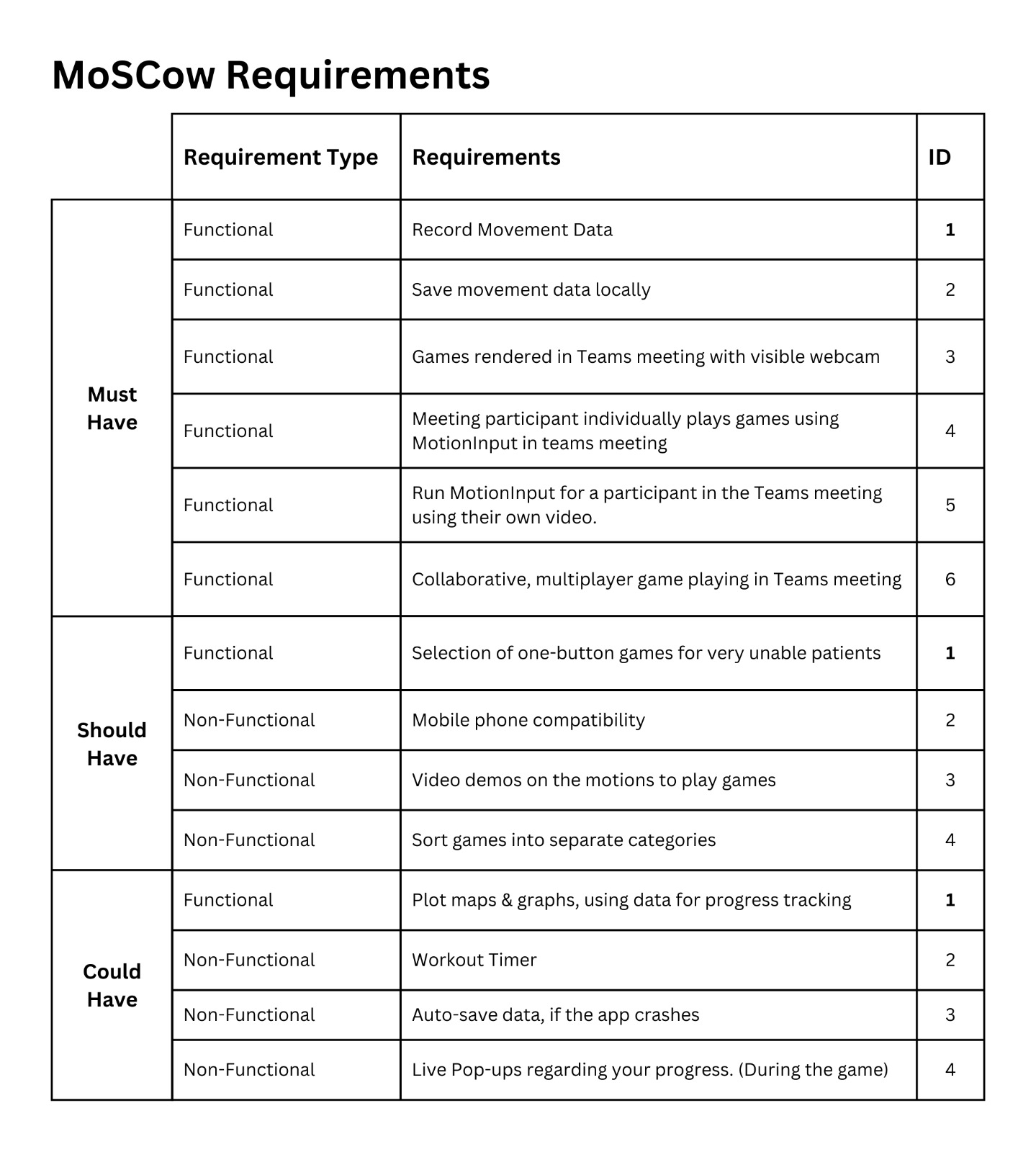Project Background
MotionInput is a UCL open source project that utilises webcam-based gesture recognition to give users a touchless-computer interaction experience. This technology is particularly useful for physiotherapy patients, who may have limited mobility and struggle to use traditional input devices. Our project aims to provide physiotherapy patients with an easily accessible way to remotely play games using MotionInput, during their therapy sessions in Microsoft Teams. Windows and Microsoft Teams are two widely used platforms, with Windows being the most popular operating system for personal computers and Teams being a popular communication and collaboration tool for businesses and individuals alike. Furthermore, with our aspiring technology, MacBook users can participate in our virtual physiotherapy. This means that there is a large potential user base for our project, with many people already using these platforms. However, currently there are no competitors or options available for physiotherapy patients to remotely play games using MotionInput or Kinect technology, which presents an exciting opportunity for us to innovate and create something unique to meet this need. With this project, we relish to provide an effective and engaging solution to help physiotherapy patients improve their physical abilities and overall well-being. As well as aiding physiotherapists in running physiotherapy sessions and managing patients’ progress details with our effective data collection techniques.
Client Requirements
For this project, our primary client was Microsoft, specifically the Microsoft Teams Team based in Redmond. Our initial meetings with Ayca Bas and Lee Stott were focused on introducing our project plan and discussing the goals and expectations. Another client we liasied with was the NHS. Senior NHS staff visited campus, to whom we explained our project background. Our conversation was insightful, and helped us derive core functionalities to implement, that would increase the utility of our work for a large organisation such as the NHS. Furthermore, throughout the project, we had regular weekly catch-up and debugging sessions with our partners at Microsoft where we could showcase our progress and also receive valuable feedback from the Teams Team to help with our development. Throughout the project, we benefited greatly from the expertise and guidance provided by Ayca and Lee, particularly in the area of Teams integration, which was a critical component of our solution. Thanks to their support, we were able to deliver a robust and user-friendly product that met the needs of our target audience. At the start of the project, we had decided on a few key points and goals to focus on:
- Ensure that the solution is scalable and can be developed and grown further with time.
- Develop a solution that is easy to navigate and launch for patients.
- Ensure that the solution integrates easily with the Microsoft Teams platform.
Project Goals
Create a unique and engaging solution for physiotherapy patients
Seamless integration with Microsoft Teams
Allow for tracking of patient progress
The project aims to create a solution that will make physiotherapy more engaging and fun for patients by allowing them to play games using motion input during their remote sessions. Furthermore, the desired solution should not be reliant on the user to manage their own technical setup. This is because we want the software to be easy to use and understand for all our target demographics, which includes elderly patients.
One of the key goals of the project is to seamlessly integrate games and run MotionInput for patients with Microsoft Teams, one of the most widely used video conferencing platforms. This will make it easy and accessible for physiotherapy patients and healthcare professionals to use without having to switch between different applications.
The project also aims to allow for easy tracking of patient progress by integrating a data tracking system using effective data gathering metrics. This will enable physiotherapists to track patients' exercise sessions. Whilst allowing patients to view and analyse their progress over time, which can help motivate them to continue their physiotherapy sessions and reach their goals.
User Interviews
We conducted interviews with our two targeted users (patient and physiotherapist) to further understand their motivations and challenges when it comes to phsyiotherapy.
Q: Could you tell us a bit about yourself, and why you require physiotherapy?
A: I am a 45-year-old man. I injured my elbow while playing Golf. I damaged my Ulnar nerve and now require a physiotherapy program.
Q: Would you prefer 1-on-1 physiotherapy or group physiotherapy, and why?
A: Group physiotherapy as then I can use someone as a benchmark, encouraging me to work harder in my sessions. Also, being a comfortable and enjoyable environment, compared to performing prescribed exercises in an isolated environment.
Q: Have you ever undergone group treatment with other physiotherapy patients? If yes, how does the platform work
A: No
Q: Would you be interested in a motion-sensing multiplayer games app, for physiotherapy patients?
A: Yes, most definitely! It sounds very exciting and fun.
Q: Ok great. So, what features would you look for?
A: Firstly, all options should be easy to navigate and click. You should perhaps segment games into the body part they work out, so we can make our own workout regimes. Furthermore, I would want a wide selection of single-player and multiplayer which lots of different genres on the application.
Then I should be able to track my progress, maybe measuring reps done of each exercise, this would definitely motivate me. A key feature would have to be not needing to download anything complicated to use on my computer. I am not very tech-savvy so it would be ideal if complications are kept away from my end.
Q: Tell us about how you get patients to exercise outside of scheduled sessions?
A: At the end of our sessions, I give my patients a sheet of different exercises they should do for their specific conditions. I write how often these exercises should be done, as well as the repetitions and sets needed for each exercise. I rarely check on my patients' in-between appointments to see if they are doing their exercises at home, I just hope they do.
Q: What is currently your biggest struggle in delivering effective physiotherapy to patients?
A: I often encounter patients with a lack of motivation for quick recovery. They don't adopt healthy lifestyle habits - which is out of my control completely. However, often they don't do their prescribed exercises. This slows down the whole recovery process. Furthermore, some patients do some exercises and leave out others; only do some sets. This makes it challenging to track progress.
Q: Do you currently run online physiotherapy sessions? If so, how is it formatted?
A: Yes, for particularly immobile patients or those who are unwell, we run appointments on Zoom. It is a call where we catch-up on their progress, I visually see how well they are moving. And then I recommend what they should do until the next appointment.
Q: Ok, imagine an application within a Teams meeting where patients can play games with different body parts for physiotherapy. Does this sound like a useful product that you would use?
A: Yes, this would solve a number of my issues. Firstly, this fun physiotherapy method would motivate a number of my youthful patients to actually exercise when home. Secondly, I would be able to visually see improvements in my patients in the way they play the games probably. And finally, if I can see what my patients have been doing on the application, then it will be brilliant for tracking progress. Such an app would make my life easier.
Q: What features you would prefer on this kind of application?
A: Firstly, the fact that I can see what my patients have been doing and tracking how well they moved when playing these games. Maybe feed me back some data, like the time they spent playing games. You know, useful metrics.
If the patients can just set up the app at home, play, do exercise without needing me, this would be useful at times. However, I would sometimes prefer being present and watching patients use the application live, as this could perhaps become a new way for me to run physiotherapy sessions.
Personas
To gain a deeper understanding of our users we drafted personas, touching two opposite ends of the spectrum. We feel this would help us gage the vast range of different people using our app.


Persona 1:Jose Northrop is a teenager suffering from partial paralysis caused by a skiing accident. He's been told to refer to physiotherapy for his recovery. While staying at home which gives him the opportunity for practice and rehabilitation, he logs into our app and targets his upper body movements and selects to play pong. Having someone with almost the same background intensifies his effort to improve. During the game Jose receives a feedback notification telling him he is doing good work today which helps increase his attention span. When the game ends, his able to view the data from that session and determine how close he is to his goal of playing sports again. Persona 2:Lorraine McGill is an elderly woman who is dealing with restricted upper body movement due to aging and has been a physiotherapy patient for a while now. She logs into this app and targets her arms by choosing to play chess straight forward. This is a nostalgic game for her and playing with a real opponent in the same stage of their treatment makes her more interested in playing. Before playing the game, she's been given all the information about the effects this game has on her strength and mobility, so she has full clarity. When the times up, and her data is viewed by the physiotherapist, feedback is then given to her. Seeing her progress after a few sessions is one way of keeping her motivated.
Use Cases
After conducting our research and interviews, and discussions with our clients, we made a use case list and examples, to better help understand our user's needs and goals to identify their requirements:


MoSCoW List
After our discussions with our client partners, Professor Dean, and internal meetings, we created a MoSCoW requirement list to inform our goals for the project. This allowed us to easily check our progress by comparing the number of points on the list that we have successfully implemented or achieved.



